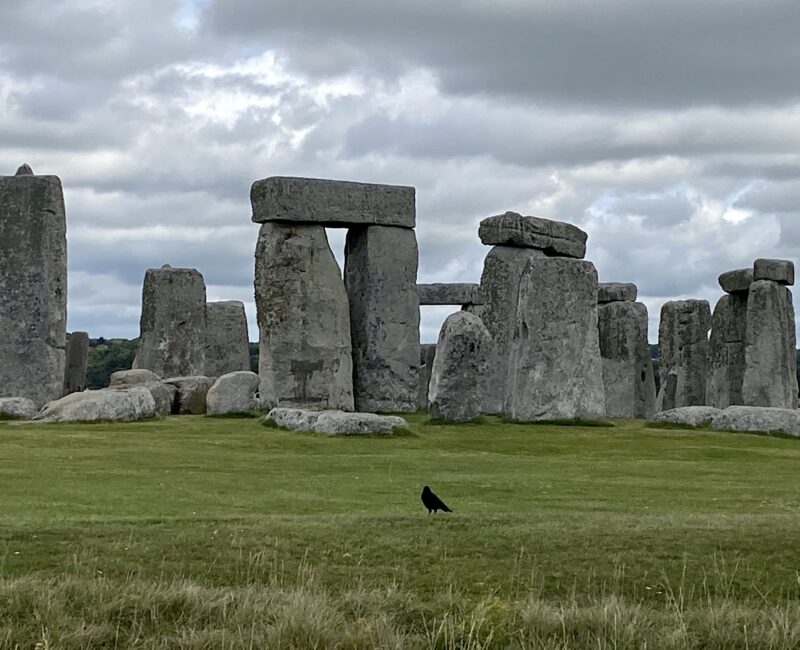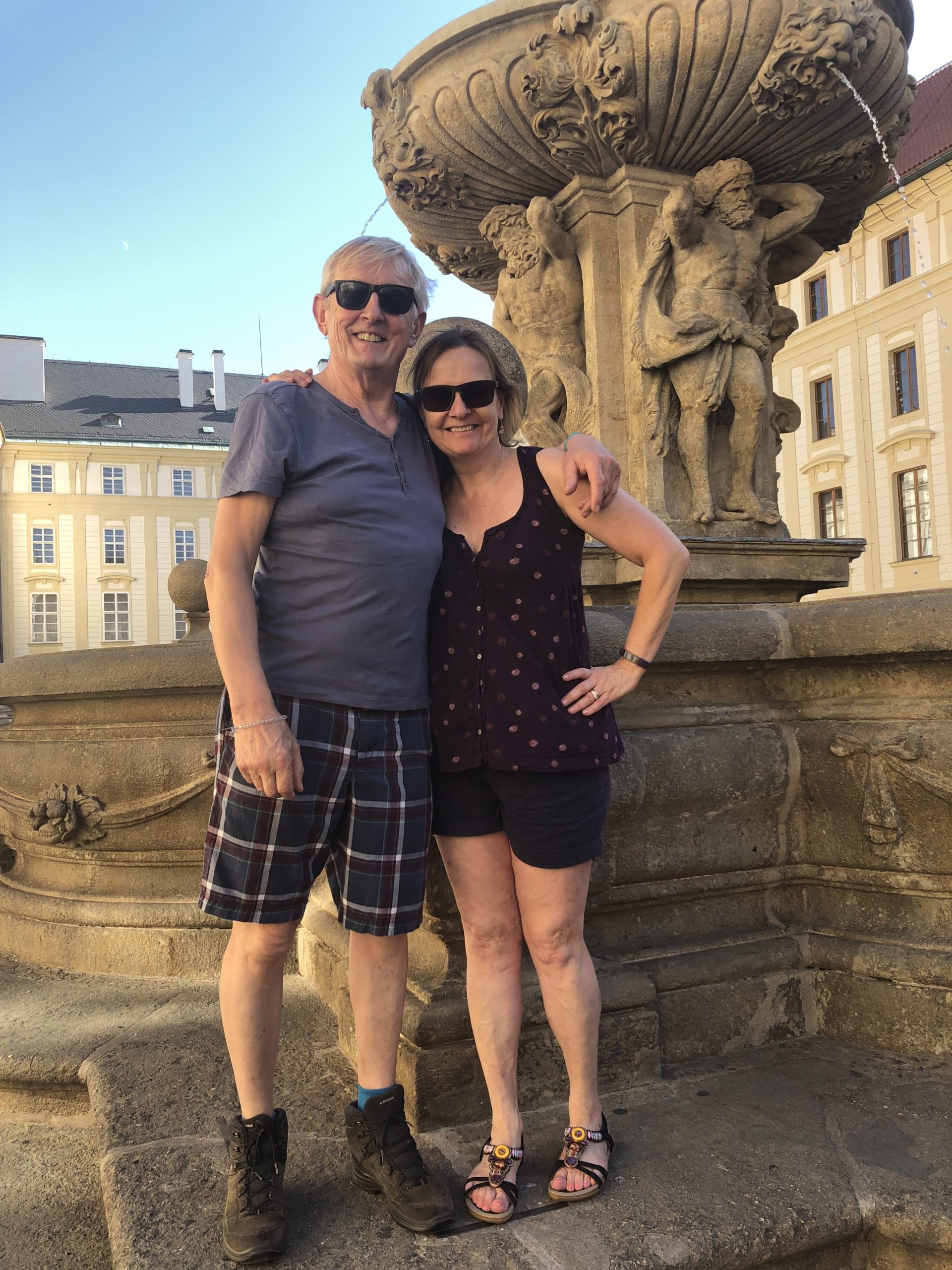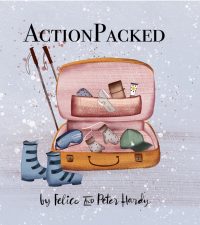
Photo: © F.Hardy.
Heather We know people were living here right back at about 8000 B.C. People look at them from afar and think: ‘Oh, it’s not that big.’ But it’s only when you get up close you realise the scale.
Peter Welcome to our travel podcast. We’re specialist travel writers and we’ve spent half a lifetime exploring every corner of the world.
Felice So we want to share with you some of our extraordinary experiences and the amazing people we’ve met along the way.
Peter So this week, we’re on the road – the A303 in Wiltshire, to be exact, on our way to explore the great Neolithic monument at Stonehenge.
Felice Right now we’re in the traffic, but at least it’s a weekday and we’re moving. If you don’t know the A303, this is one of the two main roads to the west country. In summer it’s nearly always jammed with cars and caravans packed full of holidaymakers heading for the seaside in Devon and Cornwall. And people actually slow down when they go past Stonehenge so that they can have a look out of the window. Have you actually been to Stonehenge, Peter?
Peter Well, I’ve driven by it a thousand times, and I did once go to the Summer Solstice in June, many years ago. All I can remember was it was raining and this kind of put the dampers on a crowd that had a collective hangover from the night before. A couple of druids in full ceremonial dress tried to make the best of what was a very soggy dawn. But sadly, there was no sudden flash of light on the Altar Stone at sunrise. What about you?
Felice Yes, I went years ago when I was a teenager. And in those days you could sit on the stones, you could climb them, people lay on them. Nowadays, you’re not even allowed to touch them. I think occasionally you can…on certain days you can touch them, but otherwise it’s all cordoned off and you just have to look.
Peter Well, we’re going to find out about that when we finally get there. We’re actually now just drawing into the car park of the Visitor Centre, new they call it – it was actually set up seven years ago. And it’s pretty impressive; some sort of wooden buildings that meld gently into the Wiltshire landscape, which is really very beautiful around here. There’s lots of sheep around it.
Felice It’s actually quite an attractive modern building, but it fits in very well. And I didn’t even know there was a Visitor Centre before, so I’m looking forward to seeing it.

The Visitor Centre. Photo: © F.Hardy.
Peter Yes, we’re not actually near Stonehenge itself now. We’ve driven past it, turned off down the side road and it’s probably, I don’t know, probably the best part of a mile’s walk. I know it’s about half an hour actually to walk leisurely from the Visitor Centre to the stones themselves. You can also take a shuttle bus. I think we’ll we’ll take the bus one way and maybe walk the other way. Let’s see how we get on.
Now we’ve come here to meet Dr Heather Sebire, who’s the senior curator for Stonehenge, for English Heritage that owns and runs it these days, and she hopefully can tell us all about the history of the stones and how they arrived here, some of them from Wales I believe, and some from the Marlborough Downs about 15 miles away. Let’s go and find her.
Felice We’re pretty exposed here to the elements on the edge of Salisbury Plain. It is blowing very, very hard and we’re going to have to apologise in advance for the wind noise.
Peter Yes, I don’t suppose Neolithic man or woman was too worried about microphones and sound quality.
Felice I expect they were more concerned with spearing a pig or whatever they wanted for dinner.
Peter Heather, thank you very much for appearing on our travel podcast today. A lot of people would describe it as just a bunch of rocks in the middle of a field, but it’s also one of the most popular tourist sites in the world and arguably the most important Neolithic site.
Heather Yes, it is very popular, but that’s because it is unique in the world, it is an amazing icon of prehistory, British prehistory as it happens, because this is where we are. But, yes, it’s absolutely unique.
Peter This was an important prehistoric site long before Stonehenge was built, is that right?
Heather Yes, that’s the thing. People come to see the actual monument, but actually it sits in this amazing prehistoric landscape. There were monuments that were here much earlier than Stonehenge and later as well, I’m going to say monuments…that’s really what survives in terms of burial sites, for example. But we know people were living here right back at about 8000 B.C. in the Mesolithic. And there are some postholes in what was the old car park that have radiocarbon dates that go back to that time.
And those people would have been gathering their food. They would have been using the river, the River Avon is not too far away, but you can’t see it from here. And our environmental colleagues tell us that it would have been a very open…it wouldn’t necessarily be in densely wooded land, it would have been open scrubland, so there was probably a lot of nuts and berries that they could live on.
Peter It probably hasn’t changed an enormous amount compared to today?
Heather Not a huge amount, we don’t think. Probably would have been more trees. They’re much more focused the trees today, because bits have been cleared and what have you. But yes, it wouldn’t have been that different. And then in the early Neolithic, when people start farming their agriculture, so they start settling down and they’re producing their own food, if you like, so that they were able to stay in one place.
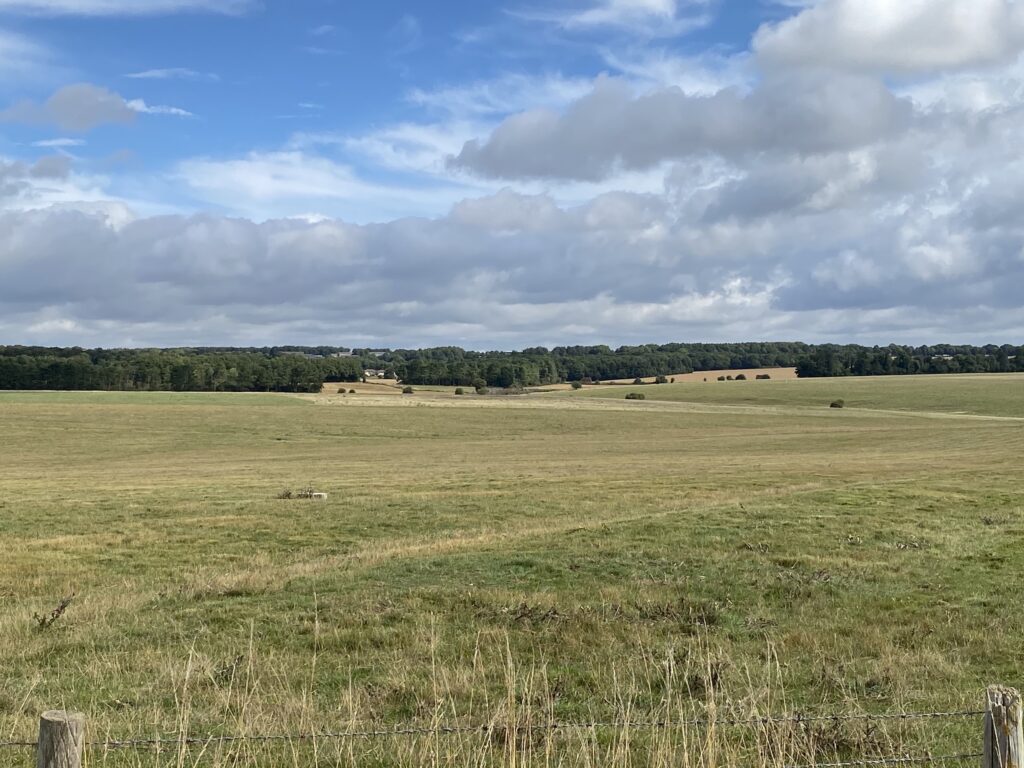
Surrounding landscape. Photo: © F.Hardy.
And we’ve got some remains from that time as well, so just before Stonehenge there are burial monuments. One of the ways they buried their dead was in huge long barrows. And there’s a fantastic example over at Winterbourne Stoke roundabout, which visitors come past. And in fact, one of the people that was buried there is talked about in the display in the exhibition. There’s also a huge linear monument that runs right across the landscape to the north of us here, that’s called the Curcus. And it’s called that because antiquarians didn’t know what it was and they used the term, you know, for a running track, a Roman running track. To be honest, we’re still not absolutely sure what it is, but we think it was probably built in stages. It’s a long line in the landscape defined by banks and ditches and runs for nearly a mile just to the north of Stonehenge here. And that was built sometime before the monument itself, before Stonehenge itself, round about 3600 B.C.
Peter So now we’re actually at Stonehenge and we’re standing by what a lot of people describe is just a bunch of rocks in a field, but is a bit more than that to put it mildly, isn’t it?
Heather It certainly is, yes. It’s an amazing monument. One of the things we were able to do when we were putting the exhibition together for the new Visitor Centre seven years ago now, was we have a laser scan now of every stone. And that proved that it is a unique monument in that it has been worked, it has been fashioned. The main stone circle fits together with mortise and tenon joints and the equivalent of tongue-and-groove joints as well. It is architectural and that’s what makes it so unique. There’s nothing like it in the world. And the stone…the features of the stone, the sarsen stones, particularly the huge sarsen stones, they’re incredibly dense, they’re incredibly hard sandstone and how anyone ever wrote them…I think, to be honest, you’d have a job to do today with modern equipment. So obviously either a labour of love or somebody giving the orders, but it is a remarkable feat of engineering.
Felice People always wonder how the stones got here and where they came from.
Heather Well, we’ve got some new interesting information about that because various academic geologists have been working on that for some time. And we’re fairly sure now that the huge giant sarsens came from the Marlborough Downs, but a place called West Woods, that is a forestry commission site. And what happened was, we were approached by Brighton University and a professor, David Nash, asked if he could do nonintrusive work at the stones.
So in days gone by, geologists would have had to chip a bit off, which of course we don’t really encourage today, even with a little tiny diamond drills. So he was able to do chemical analysis using an XRF machine – it’s almost like a sort of X-ray type thing. And he was able to hold it very close to the stones and read the chemical analysis. And then he spent some time going around the landscape to try and find a good match for it, and he did find this match in West Woods, which is some way to the north.
Peter And in fact it’s only about 15 miles away that the stones would have come from. I say only 15, because if you drag these…what do they weigh, these stones?
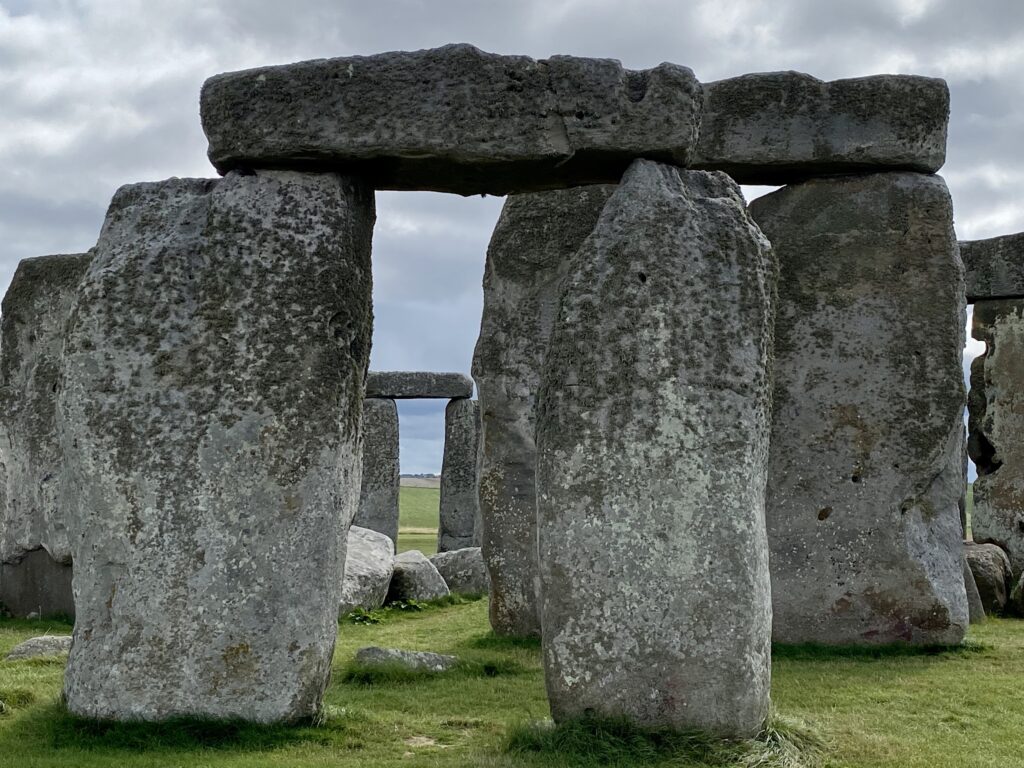
Photo: © F.Hardy.
Heather Well, some of them are up to five tons. So unbelievable how they got them here.
Peter Well, they did have the wheel, but not much else.
Heather We think it must have been on rollers; they had rope technology. Presumably there were a lot of people. They must have dragged them along the ground.
Peter It would take years.
Heather Well, quite likely, yes. And then the smaller stones, which the antiquarians call bluestones – they’re not really blue, but they have a bluish tinge to them when it’s wet. They are rialights and dialights – and we know that they came from the Preseli Hills in West Wales, which is over 100 miles away. I mean, I used to joke it was bad enough in a car on the M4, you know, going to the ferry at Pembroke.
But how people…and it’s also the level of communication that it implies, it really is quite phenomenal. But the bluestones are thought to have special qualities, they certainly have acoustic qualities. They ring; I’ve witnessed it myself. You bang them together and there’s a sort of ringing tone to them. They sparkle a bit. They’re slightly markatious, and there is a school of thought that they might have had healing qualities and perhaps that’s why they were brought.
Peter But do we know why they’re here? I mean, no one has ever really discovered what Stonehenge is?
Heather Well, what happened first was the enclosed a circular space around about 3000 B.C. by a bank in a ditch. And then we think it was some years, some hundreds of years later, that the stones actually came in. But connected with the bank and ditch was a series of pits called the Oldbury Pits, there’s 56 of them. And they held cremation burials. So that’s why you sometimes hear it said that Stonehenge is the place of the dead, not the living. We know people weren’t living here. And when they brought the stones in many generations after those, you know, those people were buried as cremations. We think it was a temple. Julian Richards, who wrote our guide book, has no qualms about calling it a temple. It’s a special spiritual place.
Felice And is there anything underneath them, under the ground? How deep are they?
Heather Underneath the stones, yes, there’s the stone circle itself – it’s been about 50% excavated. But one of the problems is there’s been very little done with modern techniques. And the whole discipline of archaeology has changed out of all recognition, like many scientific disciplines, mainly because of computer technology. So we don’t have very secure dating for the stones themselves. We have got radiocarbon dates from the dates from antler picks, for example.
The stones go down about a third again, so they are quite secure. But there was a lot of renovation work done in the early 1900s and then later in the 1960s as well. But there is a lot of buried archaeology still there, that would give more information. But there’s a sort of philosophical thought that perhaps it should be left because science is improving all the time, getting more sophisticated all the time. So there have been various universities working in the landscape. So there was a huge project called the Stonehenge Riverside Project, and that was looking at the landscape, but in particular with the River Avon as well. And in fact, in front of us is a feature that we think came just after the stones came in called The Avenue, which is a long, linear feature that runs for nearly a mile zone to the north of Stonehenge, up and over what is now called King Barrow Ridge, over the modern A303 road and drops down into west Amesbury by the river. And it’s thought that was a processional way to come up to Stonehenge.
Peter Tell me about the Summer Solstice, because this is the time when most people gather at Stonehenge. What does it actually mark?
Heather This is the time of the year in the summer when it’s the longest period of daylight. I’ve mentioned that we’ve had a laser scan of every stone and that helped us to prove that the alignment is such that the stone part of the monument is built so that when the summer sun rise comes up, it comes right through the centre of what we think is the entrance, and onto a stone that’s called the alter stone. It’s now on the ground, but we’re fairly sure it was stood up.
And then in the winter, which is the shortest day of the year, we almost feel that might have been more important because it’s the shortest day of the year and those people would have been very much aware of the seasons of daylight – much more than we are sitting with our electric lights on –and so that they probably knew that was the turning of the year and after that things would probably get better, weather-wise, and it would warm up and hopefully their crops would grow again.
So the summer sunrise comes up in the north-eastern horizon, but the midwinter sunset is over to the south-western horizon. And as I say, we think that was possibly almost more important. There are people that are called archeo-astronomy these days, who have done a lot of work on whether the moon was just as important. But it’s much more difficult to measure the lunar standstills and the movements of the moon. But again, you know, it would have been very visible to people here. And then the equinoxes in between the solstices are quite hard to to actually measure, apparently. But again, I think we have to remember they were just as clever as us. They may have had people that we would have called astronomers.
Peter And we don’t know of any organised religion? I mean, Druids were always connected with Stonehenge – is that a reality?
Heather Druidism is really a historic connection, because as I’m sure you know, the Roman authors mention the Druids as Celtic priests and what we now call Wales. And then in the modern times, going back to Victorian times, they’ve sort of almost reinvented themselves. And there are people who believe in the principles of this, and they believe Stonehenge is their place of worship. To them, it’s the equivalent of Salisbury Cathedral. So it’s quite difficult to accommodate those people, particularly at the times of the solstices – because it’s very important to them – alongside the general public who just want to come and have a good time, particularly at the Summer Solstice.
Peter Yes, there’s a kind of contrast between religion and entertainment here.
Heather Absolutely.
Felice On the Summer Solstice, for instance, can you go and touch the stones?
Heather We have a set of regulations asking people not to touch the stones. But the reality is there are so many people that it’s very difficult for us to stop people touching the stones. But on a normal visit, we don’t allow people to touch them. So the pagan observances where people are allowed in – so the Summer and Winter Solstice and the equinoxes, the Spring and Autumn Equinoxes, you know – those are four times of the year when people do tend to touch the stones. But it’s balanced by the fact that we don’t touch them or the rest of the time.
Felice Have any of the stones ever been repaired?
Heather Yes, quite a lot. We celebrated a couple of years ago when Stonehenge was given to the nation, a hundred years ago. And at that time, it was quite dilapidated and some of the stones were actually held up by wooden poles. And there was a little bit of propping up done then. But then there were archaeological excavations done in the 1960. As part of that work there was of Professor Richard Atkinson, who did a lot of that work. And after the excavations, he discussed with what was then the Ministry of Works, which eventually became English Heritage, and they decided to do quite a lot of propping up to the extent that we would not do today.
So some of the stones were re-bedded in concrete. And this one stone where you can actually see they’ve put concrete in one of the solution holes. The geology of the stones means that some natural holes form and they decided to prop that one up with concrete. We have a different regime today. I mean, we do check it from an engineering point of view; we don’t want any of the lintels to fall on anyone’s head, obviously, but we wouldn’t do such major interventions today.
Peter And do we have any idea how they got the lintels up there?
Heather Good question, that’s why everybody’s fascinated by. There’s been various experiments done over the years. Again, you know, they had rope technology; they might have built ramps to take them up to the top. They may have tried to erect them already in place, but that would have been a huge effort. So we think it’s probably more likely that they put the uprights in first and then they built ramps up. But it is really still quite a mystery.
Peter I mean, it’s like the pyramids – that one never quite knows.
Heather There are various theories, as I say, experimental archaeology has been done. We actually have had some experimental events ourselves over the last couple of years where we’ve actually raised a smaller stone, more about the size of the bluestones, which aren’t as big as the massive sarsens. And actually with about 20 people, it’s not that difficult to erect a single stone. But of course, you’re quite right, it’s putting the lintels on that really was the amazing feat.
Peter So how high off the ground are the lintels?
Heather The tallest ones are about three and a half metres.
Peter And that’s a big lift, isn’t it?
Heather No, I don’t think so. I know people like to look at it from afar, but they don’t really appreciate the complexity of it.
Felice How many stones are there altogether?
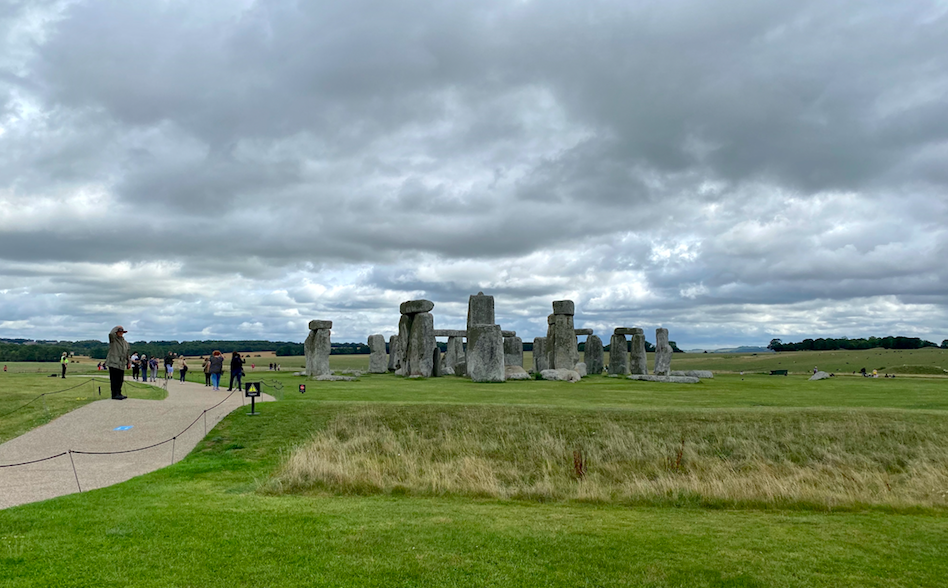
The walk to Stonehenge. Photo: © F.Hardy.
Heather Well, here originally there would have been 30 of the huge upright lintels forming the circle, with 30 lintels as well. And then one of the most impressive features is that they then built a horseshoe – well, we call it horseshoe-shape now – facing down to the northeast on that solstice alignment. And that’s the classic image of Stonehenge with the two uprights and the lintel that forms the trilithon with three stones – just the Greek word that means ‘three stones’. You can see this beautiful stone in front of me here where you can still see the tenant giant on the top, and its partner is on the ground.
So there are over 80 stones that survived, but it’s only a fraction of what would have been there. What we do know, though, from recent excavations, is that people were living at Durrington Walls, which is a little way off to the northeast. During excavations there, the floor plans of houses were found, so it gave you the impression there was a village. And we got a lot of information from that excavation and particularly what they were eating and even from pig bones, for example, they were able to tell when the pigs were slaughtered, they weren’t very old. So it could have been that people came seasonally and stayed some way off and then came to help erect this huge…I keep using the word monument, although it’s not really a good way to describe it.
On a normal year, we now have well over a million probably in there. So a million and a half visitors from all around the world. And of course, it’s partly to do with modern tourism, because people travel a lot more probably and people have got lists of sites that they want to see. But we think most people who come really appreciate it.
Peter And now with Covid, we’re down to a considerable reduction in numbers?

Photo: © F.Hardy.
Heather Yes, it’s a huge lift, absolutely. Nearly two years ago now, we did put a scaffold tower up so we could have a really good look at the lintels – because they have been repaired in the past. Yes, it’s quite amazing just how tall they are. And I think that’s another thing for visitors, you know, people look at them from afar and think, oh, it’s not that big. Certainly when you get up close, you realise the scale of Stonehenge.
Peter Certainly when you’re driving by, you don’t see the enormity of it.
Heather Yes, we started off with about a tenth, but I think we’re up to about a fifth of our normal visitors. Because people in the UK are actually well, you know, they’re supposed to be staycationing, but people are coming and people are saying they’re going to come regularly because they enjoy it so much.
Felice Now is a good time to come because there are not many people here.
Heather It is quite a nice time to come because it’s relatively quiet and you get a chance to…you can walk down there, we’re encouraging people to walk down from the Visitor Centre…so it makes a lovely day out because you can do it in stages. You can come to the stones themselves and then you can spend time at the Visitor Centre.
Peter Unfortunately, as you can hear in the background, apart from the wind noise we have some traffic noise and A303 goes by about 400 metres away.
Heather Yes, it’s quite close.
Peter Even standing here on a weekday morning in summer, the traffic is almost at a standstill. And there’s a lot of lorries and trucks and all sorts of vehicles coming along here. All that may change, may it not?
Heather Well, there is a scheme which the government are reviewing at the moment to put the part that we can see in a bored tunnel, so all this traffic would disappear.
Peter So that will make a huge difference in terms of improving the tranquillity of the site?
Heather Yes. And people would be able to explore much more of the World Heritage site, because it’s too dangerous at the moment to explore the southern part.
Felice It’s been a big influence in literature, too. I mean, for myself, when I was a child, I read a book called Stig of the Dump, which was all about someone travelling back in time and seeing how the stones were put here. And that had a huge influence on me. And there have been a few other things. Thomas Hardy, in Tess of the d’Urbervilles, lots of things.
Heather It’s inspired a lot of cultural reaction over the years, as you say, literature and famous paintings by Constable and Turner, lots of people who, you know, have painted, written poetry about Stonehenge. It features in modern films and modern music as well. So there is a whole cultural side to Stonehenge as well. And that’s another thing that we emphasise in the exhibition, that there is the prehistory Stonehenge when it was built. But it also has a history because I think it’s amazing it’s still standing at all, and so I think that’s probably because the stones are so huge.
We know people have taken bits off in the past, but it appears in medieval documents, the Romans came as well. There has been Roman pottery found inside, but they came and respected it. There’s a Roman site not too far away. And then in medieval documents around the 10th century…people visited, and you start getting images and plans back in the 1700s as well. So it has a whole cultural life as well. An icon of modern life, really.
Peter And then there was a 16th, 17th century theory that it was a Roman monument in the first place.
Heather Well, yes, and that relates back to the antiquarians not really being able to put it into any context – like the Cursus monument being called the Curcus.
Peter Well, that’s one of the great mysteries, the excitements of it, is that we actually don’t know very much. I mean, I say that, but people like you done enormous research into it. You discovered an enormous amount about it, but there’s still a lot of unknown.
Heather There are still a lot of unknowns.

Photo: © F.Hardy.
Peter So apart from Bronze Age axes and things like that, there’s also some historic graffiti here?
Heather Some of the earliest goes back to the 1700s. And in fact, one of the most interesting ones, possibly, is the great architect, Christopher Wren, of St Paul’s Cathedral.
Peter He defaced it?
Heather Yes, well, it depends how you look at it, I suppose. He was born at East Knoyle, which is a village just down the road. But the family moved to London when he was about eight. But we know he did a survey of Salisbury Cathedral in his 20s, so we suspect that’s when he came up and carved his name on one of the stones. We discourage graffiti today, very much so, but we have got a record of all the historic graffiti.
Felice Ok, let’s head back to the Visitor Centre now.
Peter So Heather, we’re standing beside some round huts with thatched roofs. This is a kind of building you think that the builders of Stonehenge might have lived in?
Heather Yes, this is what we call our Neolithic village – a replica Neolithic village. But it’s all based on archaeology, from excavations by the Stonehenge Riverside Project at Durrington Walls, which is up to the near east. Now Durrington Walls is called ‘walls’ because it’s another henge monument. But the henge is a later part of enclosing what we think was a Neolithic village where the builders of Stonehenge most likely lived. So what we’ve got here is a piece of experimental archaeology.
All the floorplans…well, the floor plans were excavated and they were nearly all square with hearths in the middle. But what you don’t get very often when you’re digging is the superstructure. So what we’ve got here is a different roof on each hut, and that’s to try and decide which were the best types of roofs, because if you think about it, you’ve got that central hearth and the smoke’s going up. You know, they didn’t have chimneys and such that we would think of, so the smoke percolated through the roofs. And it was all built by volunteers; they worked in a very miserable winter in 2014, but it’s fantastic.
So this is what we call our outdoor gallery. We’ve got an indoor exhibition as well, which really gives all the details, setting Stonehenge in its context, in its landscape. We’ve got traditional cases with artefacts, but we’ve also got a timeline and things that you can touch and models, and a huge landscape wall that helps to show people all the different things in the landscape. And then we’ve got some fun things. We’ve got this sort of mock sarsen.
Peter So tell us about that? We’re standing beside this enormous stone or mock stone, which is on rollers.
Heather Yes. It’s to give people an idea of how they might have moved the huge sarsens through the landscape. Unfortunately, because of Covid, we haven’t got the extra bit on at the moment, which is where you can have a go at pulling it – a crowd of you normally – and there’s a little sort of scoring thing that tells you whether you would have actually been able to move it or not. But unfortunately, because of Covid we haven’t been able to.
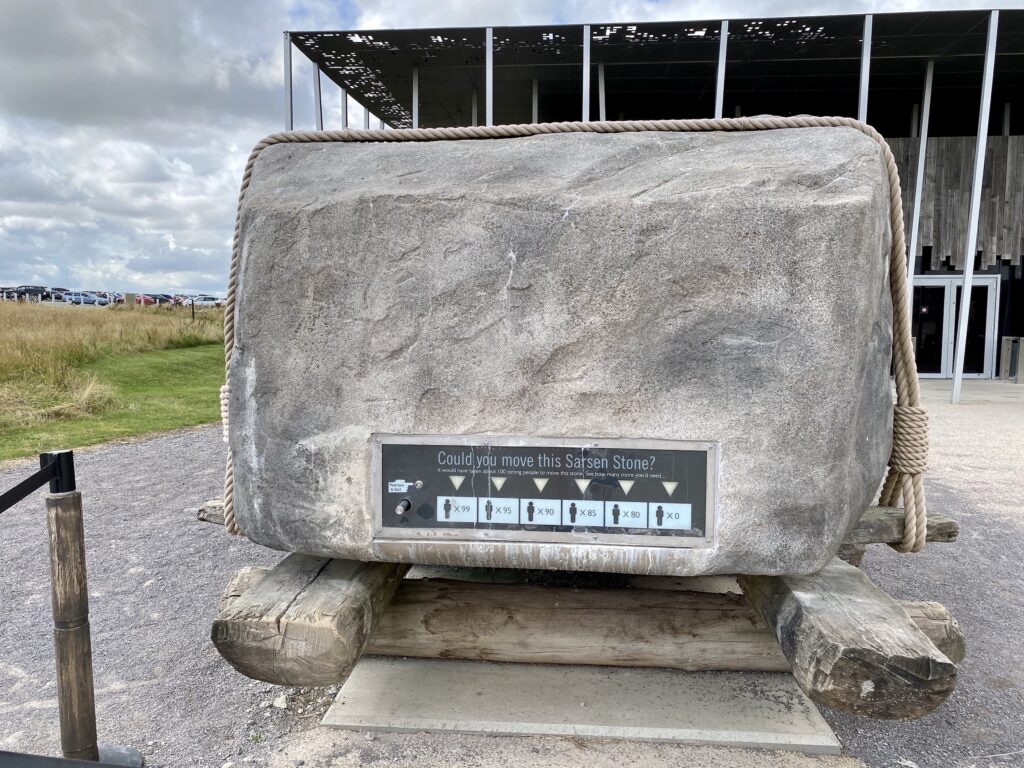
Can you move the stone? Photo: © F.Hardy
Peter People obviously have managed to move it?
Heather Yes, well, you don’t physically move it, but you got a little ‘ping’ to tell you that you might have moved it, so it’s a bit of fun. And then we’ve got to what we call touching stones. One is a sarsen, the very dense sandstone the huge sarsens are built out of, and then a typical bluestone so you can see the difference between the two geologies. We’ve got an orientation panel over towards the Visitor Centre that helps people see where they are in the landscape. So we hope there’s something for everyone in terms of the exhibition. And then we’ve got our shop, which we jokingly call our emporium.
Felice So how long would you say would be a good length of time to spend here?
Heather I think you’d need at least an hour and a half, because to be honest you could spend at least half an hour in the exhibition and then a good hour going to see the stones. But really, you want longer than that, you know, half a day if you’re on holiday or whatever, would be a good estimate. But there’s enough to do that you could come for a whole day because we encourage people to walk in the landscape and see some of those features they’ll read about in the exhibition.
Felice Is there a particular time of year that would be good?
Heather Well, we’re not open for as long in the winter, obviously because of daylight. But most people come in the summer because obviously school holidays – under normal circumstances, most people come in the summer. But it depends how hardy you are, I suppose. I really like Stonehenge in the winter because the light can be just as exciting as it is in summer and it’s very atmospheric. But obviously we get more rain in the winter, although the weather’s so erratic these days that you’re never quite sure.
Peter Do you get less traffic in the winter, too?
Heather We do get less traffic, and obviously once the schools have gone back we don’t get so many people. So some people choose to go not in school holidays to avoid families, but we’re busy all the time, to be honest.
Peter Dr Heather Sebire, thank you very much for appearing on the show.
Heather My pleasure. Thank you for coming.
Peter Now, David Nassim, you’ve come here today from Somerset and you’ve been a regular visitor over the past 10 years. You tell me you feel the stones, for you at least, have a kind of magnetic pull. Why do you think the stones are here? No one really knows do they?
David Yes, I mean, it is it is a mystery. And in a way, I’m kind of glad that there’s still some of those mysteries in the world that the scientists haven’t really figured out yet. Yes, I don’t know. It’s similar to Easter Island and other places in the world, like there’s something humans have obviously desperately needed to do. There’s been that energy in human beings, which is a very old feeling, but it’s also something that happens today. There’s this really strong feeling for people to create a monument or create art or to create something to almost say: ‘Well, we’re here.’ We want to mark that.
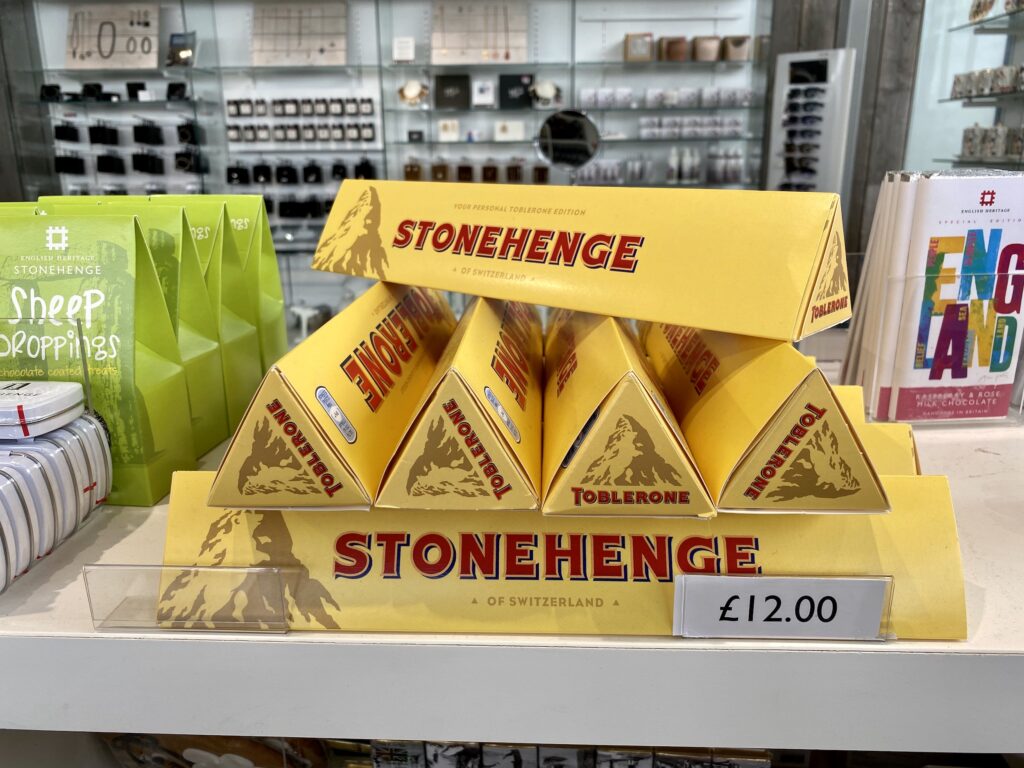
No, not the Matterhorn. Photo: © F.Hardy.
Felice Ok, let’s go to the shop now.
Peter Well, there’s a bit of everything for everybody in here, isn’t there?
Felice I mean, it’s amazing. Normally in a tourist shop, you get hats and T-shirts and models of whatever it is, like the Colosseum or the Eiffel Tower. Rock, if it’s near the seaside. But here I was amazed to see a Stonehenge neck cushion shaped like rocks and Stonehenge Toblerone – I think I’d definitely buy that one. And Stonehenge mead.
Peter …and gin.
Felice I mean, it’s amazing what they’ve thought of.
Peter And there’s lots of really quite expensive jewellery. I mean, hundreds of pounds worth of jewellery made with bluestones.
Felice Yes. So you can get really carried away on the Stonehenge theme.
Peter I could spend quite a lot of money in here quite easily, but I’m not going to. So what do you think of Stonehenge? What’s your overview of Stonehenge?
Felice Well, for years and years, I’ve just driven past it and I thought ‘There’s a pile of old rock that causes a traffic jam and you can’t really see it properly.’ But then, when I got quite close, I was amazed at how beautiful it is, actually.
Peter I think the the quality the colour of the stones is extraordinary. And it’s only when you stand really close, you get an idea of the immensity of it.
Felice And the shapes are really interesting and it really made me want to paint them.
Peter I think we’ll come back.

The sun’s out. Photo: © F.Hardy.
Check the Stonehenge website for current prices and opening times. There’s a shop and cafe on site, and a dedicated picnic area.
Felice That’s all for now. If you’ve enjoyed the show, please share this episode with at least one other person! Do also subscribe on Spotify, i-Tunes, Stitcher, or any of the many podcast providers – where you can give us a rating. You can also find us on Twitter, Facebook and Instagram. Stay safe and we’ll see you next week.
© ActionPacked Travel

- Join over a hundred thousand podcasters already using Buzzsprout to get their message out to the world.
- Following the link lets Buzzsprout know we sent you, gets you a $20 Amazon gift card if you sign up for a paid plan, and helps support our show.

